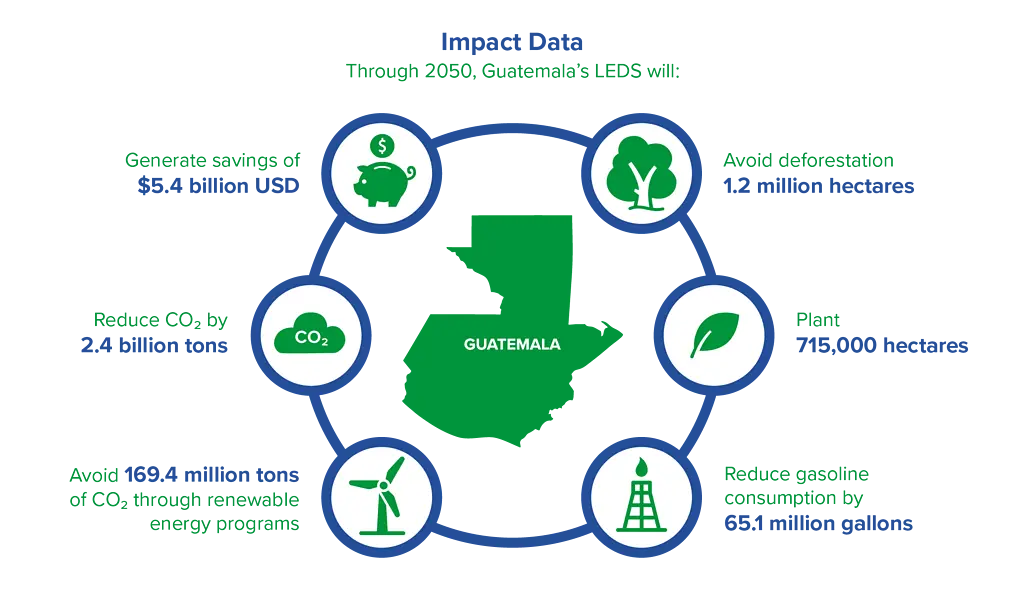Spurring economic development, social progress, and resilience to climate change
Objective
To formulate Guatemala’s first low emission development strategy.
Approach
Working with the government and multiple industries, we helped establish goals, strengthen climate science, and demonstrate the positive effects of reduced emissions on the Guatemalan economy.
Impact
We delivered a strategy that can help Guatemala reduce emissions by more than 11 percent by 2030.
If current trends continue, Guatemala’s greenhouse gas emissions will double by 2050, thereby stunting the nation’s economic and social development.
To combat this threat, USAID contracted RTI to implement the five-year Guatemala Low Emission Development Strategy (LEDS) project. With participation from more than 300 representatives in the public and private sectors, academia, indigenous organizations, cooperatives and organized groups, RTI worked with the Government of Guatemala (GOG) to formulate the country’s first LEDS.
In Guatemala, the largest sources of GHG emissions in the country are change in land use due to forest clearing, the growth of unsustainable crops, natural disasters, and the use of fossil fuels.
The strategy establishes the path for countries like Guatemala to fulfill their commitment to reduce GHG emissions. Under the project, we also worked to help build the institutional capacity of Guatemalan government agencies. Through these efforts, the effects of climate change will be reduced and GHG emissions mitigated.

Lower Emissions, Increase Opportunities
The LEDS project used science and analytics—such as establishing the country’s projected GHG emissions forecast through the year 2050 and field demonstrations—to provide evidence on low emission development benefits and opportunities. Key sectors include waste, forestry, agriculture, energy, industry, transport, urban development, and alternative land usage.
RTI—in partnership with the government—completed the LEDS action planning process using a 10-step methodology developed by project partner Center for Climate Strategies (CCS). First, the project established clear goals and began baseline development. Over the course of the following two years, we convened six working group sessions every four months and established a GHG emission baseline and forecast through 2050 that we used to define a vision for long-term development. Then, the program identified and prioritized—and later revised and validated—policy and project options. A microeconomic and macroeconomic analysis followed, helping illuminate low emission development policies’ positive effects on the Guatemalan economy. Integrating policy and project options, making final recommendations, and continuing to monitor, evaluate, and update the LEDS, was the final step in the process.
Luis Chang, Minister of Energy and Mines, emphasized the importance of this work: "The Low Emission Development Strategy will contribute to prioritizing actions to mitigate climate change to encourage investment, reduce operating costs, create new jobs, generate income, and above all, establish an economy with more resilience to the effects of climate change."
Guatemala's Continued Progress on Climate
Over the course of the LEDS action planning process, the project continued to make improvements in climate science and analytics, strengthen the government’s capacities at various levels, improve engagement and transparency with a wider network of LEDS stakeholders, demonstrate field-level activities that provide evidence on LEDS benefits, and maintain consistent messaging to showcase positive LEDS impacts and opportunities. As a result, the project supported the development of the National Determined Contribution in 2015, the approval of the National Climate Change Adaptation and Mitigation Plan the following year, and the launch of the National Energy Plan in 2017—all significant achievements made toward securing a sustainable Guatemalan future.
In October 2019, the Guatemalan Ministry of Agriculture and Livestock launched the National Sustainable Livestock Strategy, another policy developed with RTI assistance to support more sustainable, low carbon grazing models on cattle farms. To implement and oversee the strategy in 2020, the Ministry created the National Cattle Roundtable. These actions represent an important step forward in recognizing the role that the livestock sector plays in finding more sustainable production models and helping to reduce agriculture-based greenhouse gas emissions.
“We need to find better ways to produce so that our children can continue to develop the community and not have to go to other cities or countries to look for work,” said Victor Hugo López, from the Tineco agricultural association in Huehuetenango, in the country’s western highlands.
In November 2018, the GOG launched the national-level LEDS, placing it as one of the official guidance documents for Guatemala to make climate-smart investments and surpass its commitment to reducing GHG emissions by 11 percent by 2030. And in November 2020, Guatemala officially submitted the Low Emission Development Strategy to the United Nations Framework Convention on Climate Change as the country's climate action plan. The submission is a strong indicator of the Guatemalan Government's ownership of the LEDS and reflects the effectiveness of having built an active network of LEDS counterparts outside of the government that helped make the progress truly 'country-led.'
Through collaboration, alliance-building, private sector engagement, institutional strengthening, civil society and municipal empowerment, and subnational pilot activities, the LEDS Project showcased the economic, social, and environmental benefits of sound low emission planning and implementation, provided real-life examples of how LEDS can support local development objectives at various scales, and helped the Guatemalan economy move toward a more sustainable growth trajectory.
Related Insights

Leaders on the Guatemala LEDS project discuss how adapting international methodologies to local contexts helped the process succeed.
- U.S. Agency for International Development (USAID)
- Environment
- RTI Center for Climate Solutions
- Climate Change Sciences and Analysis
- Evaluating Climate Change Impacts
- Climate Change Solutions
- Climate Policy
- Climate Finance
- Clean Energy Technology and Renewables
- Climate Planning, Preparedness and Resilience
- Economic Impacts of Climate Change
- Climate Justice and Equity
- Climate and Resilience



